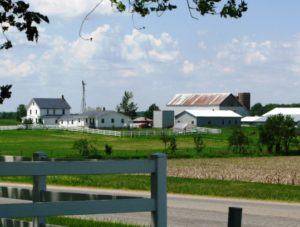People live messy lives: they make complex choices about what to eat, who to start a family with, and generally how to live their lives. Mice on the other hand are much simpler. They can live in a lab where their diet, mating and behaviour can be carefully monitored and controlled. This makes it far easier to relate mouse genetics and cell biology to things at an organism level, and there is lots we have learnt about human biology using mice as models.
But in many ways, a mouse is not quite like a human. Mice are short-lived, don’t suffer certain illnesses, and never felt the need to complicate things with a sophisticated culture. To study human disease and processes such as ageing, researchers look for human populations which are a little bit less messy than a typical community, and a little bit more like a lab mouse population. This population would ideally be composed of genetically similar people, maybe descendants of the same few founders, who tend to not marry ‘outsiders’, have good records on who is related to whom, and who have similar lifestyles.
Such a group is the Amish, a traditional Anabaptist group composed of several smaller communities throughout North America. The Amish tend to eschew outsiders and the modern world to varying extents – but many groups make an exception to participate in medical research due to their communitarian ethos. This is good news for researchers as many Amish communities were founded by a small number of people who then had large families over many generations, which means they tend to carry certain genetic traits at a higher frequency than the general population, making them ideal for tracing some of the complex genetic and cellular pathways that lead to processes such as ageing in humans.
This is precisely what a the researchers behind a paper recently published in Science Advances have done. The story starts with a protein called PAI-1, and the gene that makes it, SERPINE1. PAI-1’s full name is Plasminogen-Activator Inhibitor 1, named so because it inactivates the enzyme which breaks plasminogen into plasmin, and therefore halts a process called fibrinolysis which prevents blood clots from becoming too large. Therefore, having high levels of PAI-1 is associated with atherosclerosis and thrombosis.
Such high levels of PAI-1 is seen in cells exhibiting a condition termed SASP, or the senescence-associated secretory phenotype. SASP is not good news: it indicates that the cell will stop dividing, known as replicative senescence, and there is evidence that senescent cells accumulate in the body’s tissues and contribute to the aging process. Experimental evidence has shown that PAI-1 is critical in moving cells into this senescent state.
Biological age can be a hard thing to measure, but in this study the researchers defined it as a score bringing together measures of cardiovascular health relative to a person’s age, as well as the length of telomeres, the protective structures at the end of chromosomes. We are born with long telomeres (although how long varies between individuals), but in all body cells the telomeres get shorter with each cell division as the cellular machinery cannot copy the very end of a DNA molecule. When the telomeres become too short, the whole chromosome can’t be copied, and the cell can no longer divide. Previous research suggests that being born with longer telomeres means you might be more likely to live longer, and are likely to get age-associated conditions such as CVD and insulin resistance at an older age.
Previous research on PAI-1, telomere length, replicative senescence, and diseases like diabetes and CVD suggested to the researchers that there might be a link connecting these factors – and that this link might form a crucial part of the network that leads to ageing in humans. To investigate this, they drew on previous research which had identified a rare mutation in the SERPINE1 gene among the Old Order Amish. This mutant PAI-1 protein doesn’t function, so those with at least one copy of the mutant allele had life-long reduction in PAI-1. The relatively high frequency of a rare mutation in a population known to be useful in genetics studies suggested to the researchers that they should investigate further. They collaborated with an Old Order Amish community in Berne, Indiana and enrolled 177 participants. Of these, 43 people had one copy of the mutant allele of the SERPINE1 gene (heterozygotes) and 7 had two copies (homozygotes).
Being homozygous for the mutant allele is no good thing – it leads to a bleeding disorder known as haemorrhagic diathesis, and finding ways to combat it is part of why the community agreed to participate in the research. But it seems heterozygosity can have its benefits. Researchers found that carriers had a 10% longer mean telomere length than non-carriers, as well as a longer median survival, living to 85 years compared to 75 years for non-carriers. Further, no carriers had type 2 diabetes, compared to 7% of non-carriers. There was no difference in mean BMI, but this may be because of the similar lifestyles of individuals in a community, which is likely the cause of the better cardiovascular and metabolic health enjoyed by the Amish overall compared to the general US population.
Many existing purportedly anti-aging treatments and drugs involve a reduction in the levels of PAI-1, and this study could lead to further development of these sorts of interventions. But PAI-1 can’t be thought of the ultimate cause of ageing; tracking down a single aging-related gene is not like discovering the fountain of youth. Genetics are complex, and despite the harmful effects of high PAI-1, it is essential for its roles in blood clotting. It will also be necessary to expand research to other communities given the unusually healthy lifestyles the Amish lead. The solution to combating the diseases associated ageing will not be simple, but will rather involve subtle tweaks to the composition and activity of the body’s cells.
